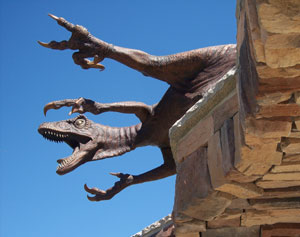Prazen’s work featured at prehistoric museum

This archived article was written by: Benjamin Waldon
Showing in CEU’s Prehistoric Museum Art Gallery this month is 18 bronze sculptures created by renowned local artists Gary Prazen and Danny Blanton.
Blanton, Prazen’s son-in-law, contributed to the exhibit with his Utah State Fair award-winning Eagles which are composed of steel, bronze and copper. The two Eagles were named best of show, one in the year 2002, and the other in 2003.
Prazen contributed to the exhibit with bronze sculptures reflecting the connection of people and the mining industry and also with his bronze sculptures of dolphins. Some of these sculptures are priced for sale and can be found on the website www.original-creations.com.
Blanton, a ’99 graduate from Carbon High School, stated in a 2002 article in the Sun Advocate that making these sculptures was, “like assembling a puzzle. I really had to study the anatomy of the bird,” and that “there will never be another piece exactly like this.”
Turning out to be true in that one of the Eagles won two awards at the state fair; those awards were the Best of Show and the People’s Choice award. “You can’t help be motivated and creative when you are around Gary.”
Prazen, the man behind the bronze, was born and raised in the mining community and culture of this area. He taught welding classes at college for a few years and began his sculpting in 1978 when he produced his first bronze, the John Wayne sculpture which he presented to the Hollywood actor. Since then his work exhibits the culture folklore and “characters that make up the mining industry.”
Prazen’s work has developed to a point at which his work can be seen in museums and private collections across the nation.
A 2002 article in the Sun Advocate covers how Prazen creates his work: “there are 33 steps in creating a bronze, beginning with the clay sculpture. The complicated process includes a wax solution, making the bronze hollow, and then sprewing the wax figures. The pieces are dipped in slurry and coats of sand are applied. The base is cut off and, holes drilled and the pieces are stacked in a coal cart before they are rolled into an oven and cooked at 1500 degrees Fahrenheit. This melts the wax and leaves a ceramic shell. The bronze is poured at 2150 degrees. The slurry is chipped off, welded and then ground in preparation for the finishing process. This includes a sand blasting process, a coat of sulphuric nitrate, buffed and oiled.”
Prazen creates his work for more than just show, but for special people and places as well. Prazen also helps with the National Mining Hall of Fame and Museum and belongs to the National Sculpting Society.
Prazen and Blanton’s work can be seen in the CEU Prehistoric Museum throughout September on the second floor. When their work leaves the museum, there will always be at least one piece hanging around, and that would be the six-foot by 14-foot sculpture of the Utah Raptor which is outside of the museum on 100 North and 100 East.
“Gary’s creativity and detail combined with Danny’s skill and precision have combined to create a dynamic, active, and more than a bit fearsome, life-sized Mesozoic predator.” said Museum Curator Reese Barrick Ph.D.




